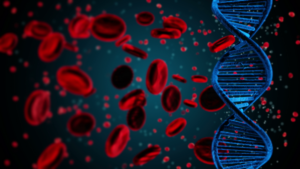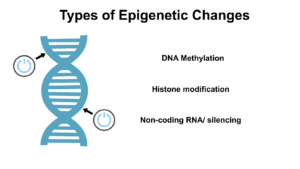DNA methylation, a fundamental epigenetic process, has a profound influence on gene expression and cellular function. This chemical modification of DNA plays a crucial role in various biological phenomena, including X chromosome inactivation and gene silencing. Understanding what affects DNA methylation status is essential to grasp its impact on human health, development, and disease susceptibility.
The status of DNA methylation is shaped by a complex interplay of genetic and environmental factors. Genetic predisposition has an impact on methylation patterns, but environmental exposures and lifestyle choices also contribute significantly. From diet and stress to toxins and aging, numerous external influences can alter DNA methylation. This article explores the key determinants of DNA methylation status, shedding light on the delicate balance between nature and nurture in shaping our epigenetic landscape.
The nature vs nurture debate in DNA methylation
The interplay between genetic predisposition and environmental influences in shaping DNA methylation patterns has been a subject of intense research and debate. This section explores the complex relationship between nature and nurture in determining DNA methylation status.
Genetic predisposition
Genetic factors have a significant influence on DNA methylation patterns across the genome. Studies have shown that site-specific levels of DNA methylation are more strongly correlated between monozygotic (MZ) twins than dizygotic (DZ) twins, indicating a heritable component. While the average contribution of additive genetic influences on DNA methylation is relatively low, it is notably elevated at highly variable sites characterised by intermediate levels of DNA methylation.
These genetically influenced sites are often associated with DNA methylation quantitative trait loci (mQTLs), which are genetic variants that affect DNA methylation levels at specific genomic locations. Interestingly, these mQTLs frequently overlap with expression quantitative trait loci (eQTLs), suggesting a potential mechanism linking genetic variation to gene regulation.
The heritability of DNA methylation varies across different genomic regions. Twin studies have estimated that the proportion of variance in DNA methylation explained by genetic factors ranges from 5 % to 19 % at the majority of sites tested across the genome. However, this contribution can be significantly higher at certain loci, particularly those with intermediate levels of DNA methylation or high variability.
Environmental influences
Environmental factors play a crucial role in shaping DNA methylation patterns, especially during critical periods of development such as embryogenesis and gametogenesis. These developmental processes involve extensive epigenetic reprogramming and are particularly susceptible to environmental perturbations that may alter the epigenome, gene expression, and ultimately, cellular function and physiology.
Various environmental exposures have been associated with changes in DNA methylation. For instance, maternal dietary interventions, such as protein restriction or high-fat diets, have been linked to altered DNA methylation patterns in offspring. In some cases, these changes persist after cessation of exposure and are associated with altered gene expression of nearby phenotype-associated genes.
Environmental toxicants can also have an impact on DNA methylation, particularly during the in utero period when epigenomic profiles are being established. Studies have shown that prenatal exposure to substances like cigarette smoke and toxic trace metals (e.g., arsenic, mercury, and manganese) can lead to genome-wide and gene-specific DNA methylation changes in human populations.
It’s important to note that environmentally induced DNA methylation changes can be either cell-type specific or affect multiple lineages, depending on the genomic regions involved and the timing of the exposure. Some regions, known as metastable epialleles, may retain environmental influences on DNA methylation across multiple cell types into adulthood.
Interaction between genes and environment
The complex interplay between genetic and environmental factors in shaping DNA methylation patterns is becoming increasingly apparent. Recent studies have shown that genetic and environmental factors in combination best explain DNA methylation at the majority of variably methylated regions (VMRs).
In a comprehensive study of 237 neonate methylomes derived from umbilical cord tissue, researchers found that 75 % of the VMRs were best explained by the interaction between genotype and environmental factors (GxE), whereas 25 % were best explained by SNP genotype alone, and none by environmental factors alone.
These findings highlight the importance of investigating the combined effects of environmental and genetic contributions to DNA methylation, rather than focusing solely on their individual contributions. The enrichment of genetic variants from GxE models in genome-wide association studies (GWAS) for complex disorders further supports their importance for disease risk.
Understanding the intricate relationship between nature and nurture in DNA methylation is crucial for unravelling the mechanisms behind gene expression regulation and its impact on human health and development. This knowledge can potentially lead to the development of targeted interventions and personalised approaches to improve long-term health outcomes.
Environmental factors affecting DNA methylation
Environmental factors play a crucial role in shaping DNA methylation patterns, particularly during critical periods of development. These factors can have long-lasting effects on gene expression and cellular function, potentially influencing health outcomes throughout an individual’s lifetime.
Diet and nutrition
Nutrition has a powerful impact on DNA methylation pathways, serving as one of the strongest modifiable factors affecting epigenetic regulation. The relationship between diet and DNA methylation has been extensively studied in both in vitro and in vivo research, revealing that dietary components can influence global DNA methylation patterns and gene-specific methylation changes.
One of the primary mechanisms by which nutrition affects DNA methylation is through the alteration of substrates and cofactors necessary for proper methylation processes. Key methyl donors, such as S-adenosylmethionine (SAM), are synthesised in the methionine cycle with the help of various nutrients present in the diet, including methionine, folate, choline, betaine, and vitamins B2, B6, and B12. Deficiencies in these nutrients may result in changes to the SAM pool, which can influence the reaction kinetics of DNA methyltransferases (DNMTs) and, consequently, DNA methylation patterns.
Studies have shown that high dietary methionine intake is associated with increased DNA methylation, as methyl groups transferred in mammalian DNA methylation reactions are believed to ultimately derive from methionine. Similarly, high doses of folate supplementation have been observed to increase methylation and normalise gene expression at specific loci, likely due to a substantial increase in the intracellular pool of SAM and the SAM/S-adenosylhomocysteine (SAH) ratio.
Choline and betaine, important methyl donors, have also been shown to have an impact on DNA methylation. Choline methyl-deficient diets have been associated with reduced hepatic concentrations of SAM and increased levels of SAH in the livers of mice. A rat study evaluating a choline-deficient diet for seven days demonstrated significant effects on reducing liver methionine formation by 20–25 %, SAM by 60 %, and increasing liver SAH by 50 %.
Toxin exposure
Exposure to environmental toxins has been linked to alterations in DNA methylation patterns, which may have long-term consequences on health and disease susceptibility. Several classes of environmental chemicals have been identified as capable of modifying epigenetic marks, including metals, air pollutants, and endocrine-disrupting compounds.
Metals such as cadmium, arsenic, nickel, and chromium have been associated with changes in DNA methylation. For instance, cadmium, an established carcinogen with low mutagenicity, has been shown to induce oxidative stress and alter DNA methylation patterns, which may play a predominant role in its carcinogenic effects. Arsenic, another well-known carcinogen, has been linked to changes in DNA methylation through its enzymatic methylation process, which utilises SAM and may lead to depletion of methyl groups available for DNA methylation.
Air pollutants, particularly particulate matter (PM), have been associated with DNA methylation changes that may contribute to increased morbidity and mortality from cardiorespiratory diseases and lung cancer risk. Exposure to benzene, a component of air pollution, has been linked to alterations in global DNA methylation patterns and gene-specific hypermethylation or hypomethylation, which may contribute to the development of acute myelogenous leukemia (AML).
Stress and trauma
Psychological stress and trauma have been shown to have an impact on DNA methylation patterns, potentially contributing to long-term health consequences and even transgenerational effects. Studies have demonstrated that exposure to psychological trauma can affect the biology of individuals and may have biological and behavioural consequences on their offspring through epigenetic mechanisms.
Research has shown that both mothers exposed to trauma and their children exhibit higher methylation levels at specific gene promoters, such as the exon 1F promoter of NR3C1, a gene involved in stress response regulation. These methylation changes have been associated with altered cortisol levels and increased risk of post-traumatic stress disorder (PTSD) and depression.
Interestingly, the effects of trauma on DNA methylation may differ between generations. For example, a study examining transgenerational methylation changes in Holocaust survivors found significantly higher FKBP5 intron 7 methylation levels in survivors, but significantly lower levels in their offspring. This suggests that the epigenetic response to trauma may be complex and potentially adaptive across generations.
In conclusion, environmental factors such as diet, toxin exposure, and psychological stress play crucial roles in shaping DNA methylation patterns. These epigenetic modifications can have long-lasting effects on gene expression and cellular function, potentially influencing health outcomes throughout an individual’s lifetime and even across generations. Understanding these environmental influences on DNA methylation is essential for developing strategies to mitigate their potential negative impacts and promote better health outcomes.
Lifestyle choices impacting DNA methylation
Lifestyle choices play a significant role in shaping DNA methylation patterns, which in turn can influence gene expression and overall health. Three key lifestyle factors that have been shown to have an impact on DNA methylation are exercise, sleep, and substance use.
Exercise
Physical activity has emerged as a powerful stimulus that can modify DNA methylation patterns in various tissues, including skeletal muscle and blood cells. Regular exercise has been associated with changes in global DNA methylation profiles, which may contribute to the numerous health benefits of physical activity.
Studies have shown that endurance training can lead to alterations in DNA methylation patterns in skeletal muscle. For instance, research on healthy aged men who had performed regular exercise throughout their lives revealed significantly lower DNA methylation in 714 promoter regions compared to sedentary individuals of the same age. These hypomethylated promoters were associated with genes involved in energy metabolism, myogenesis, and oxidative stress resistance, suggesting that lifelong physical activity may contribute to maintaining muscle function and metabolic health during aging.
The intensity and duration of exercise also play a role in shaping DNA methylation patterns. Acute bouts of exercise have been shown to induce rapid changes in DNA methylation, particularly in genes related to metabolism and muscle function. For example, a single session of high-intensity exercise has been found to cause demethylation of gene promoters involved in energy metabolism and muscle contraction.
Interestingly, the effects of exercise on DNA methylation may extend beyond muscle tissue. Studies have reported changes in global DNA methylation levels in white blood cells following exercise interventions. However, the direction and magnitude of these changes can vary depending on the type, intensity, and duration of the exercise programme,
Sleep
Sleep is another crucial lifestyle factor that has been linked to DNA methylation patterns. Emerging evidence suggests that sleep disturbances and circadian rhythm disruptions can lead to alterations in DNA methylation, potentially contributing to the adverse health effects associated with poor sleep.
Research has shown that sleep deprivation and shift work can induce changes in DNA methylation patterns, particularly in genes involved in circadian rhythms and metabolism. For instance, a study on shift workers found that DNA methylation changes in clock genes were associated with altered gene expression and disrupted circadian rhythms.
Moreover, sleep duration has been linked to DNA methylation patterns in children and adolescents. A study examining the relationship between sleep and DNA methylation in 10-year-old children found that sleep duration was associated with methylation patterns in genes related to stress response and circadian rhythms.
Substance use
Substance use, including tobacco smoking and alcohol consumption, has been shown to have profound effects on DNA methylation patterns. These epigenetic changes may contribute to the long-term health consequences associated with substance abuse.
Tobacco smoking has been extensively studied in relation to DNA methylation. Research has demonstrated that smoking can induce widespread changes in DNA methylation patterns across the genome. For example, a study found that maternal smoking during pregnancy was associated with altered DNA methylation in newborns, particularly in genes related to development and cellular function.
Alcohol consumption has also been linked to changes in DNA methylation. Studies have shown that chronic alcohol use can lead to global DNA hypomethylation, which may contribute to the increased risk of certain cancers associated with alcohol abuse. For instance, research has found that alcohol consumption strengthens the association between LINE-1 hypomethylation (a marker of global DNA methylation) and gastric cancer risk.
In conclusion, lifestyle choices such as exercise, sleep, and substance use have significant impacts on DNA methylation patterns. These epigenetic modifications may serve as a mechanism through which lifestyle factors influence gene expression and, ultimately, health outcomes. Understanding these relationships can provide valuable insights into the molecular mechanisms underlying the health effects of various lifestyle choices and may inform strategies for promoting healthy aging and disease prevention.
What does it all mean?
The intricate interplay between genetic predisposition and environmental factors in shaping DNA methylation patterns highlights the complexity of epigenetic regulation. This article has explored various influences on DNA methylation status, ranging from inherited genetic factors to lifestyle choices and environmental exposures. The dynamic nature of DNA methylation underscores its potential as a bridge between our genes and the environment, offering insights into how external factors can impact gene expression and ultimately influence health outcomes.
Understanding the factors that affect DNA methylation opens up new avenues to explore human health and disease. It emphasises the importance of considering both genetic and environmental contributions when studying epigenetic modifications. This knowledge has implications for personalised medicine, disease prevention, and public health strategies. As research in this field continues to advance, it holds promise to unravel the complex mechanisms behind gene-environment interactions and their role in shaping human health and development.


